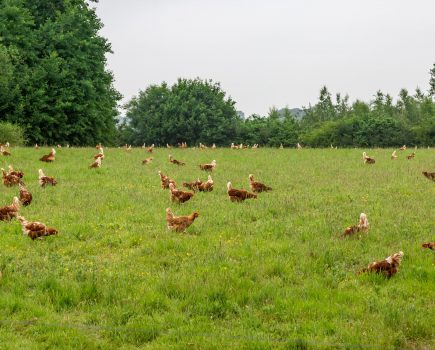Mother Nature provides your chickens with so many healthy goodies. Start making use of her medicine cabinet!

Whilst many urbanites view invasive perennial weeds as a bane to their lawns and gardens, the savvy chicken keeper should embrace them with open arms. It couldn’t be easier: the weeds grow and you harvest — it’s something you would do in any case; it’s called weeding!
The humble dandelion is one of the best known medicinal herbs in the world, flourishing in rich, moist soil almost everywhere. They’re one of the first flowers to appear in spring and one of the last plants to go dormant in the winter. As every part of the plant can be used, there’s no wastage either.
All parts of dandelions are bitter; the bitterness comes from the flavonoids that give dandelions their blood purifying properties. These pigments stimulate the digestive system, acting as a diuretic without leaching potassium and thus keep parasite overloads in check and maintain a healthy balance of microbes in the gut naturally.
Dandelions are high in beneficial fibre as well as vitamins A, B, C, E and K and are a great source of calcium (beneficial for laying hens) as well as iron, magnesium, phosphorus, potassium and zinc, all of which make it a pretty complete herb. It’s good for general energy building and nutritive tonics. However, its effects are dependant on when and where it is harvested. For example, raw leaves are ‘sweeter’ and much less bitter in spring than autumn so leaves harvested in autumn will aid digestion more than those harvested in spring. As the plant draws from its immediate environment, no two preparations will be identical. With this in mind, you should only harvest dandelions from your own property as these plants will be drawing the nutrients from the soil which your flock will find most beneficial. Never collect dandelions sprayed with chemical pesticides or those growing near the roadside.

Dandelion leaves can be fed fresh or dried. If you feed your flock more grains in the winter, treat them to dandelion leaf tea to aid food digestion. Make sure that leaves are completely dried before storing to prevent mould.
The roots are a great liver tonic. Dry and grind the long tap roots to mix in with your flock’s feed during the winter.
My flock love eating the roots raw, so I hold the whole fresh plant for them to rip at the root. Roots harvested later in the year contain the highest concentration of nutrients. If you break the plant at the top of the root and base of the stem, you’ll see a white latex milk oozing out. This latex is packed full of proteins, alkaloids, starches, sugars, oils, tannins, resins and gums which are readily devoured by my flock.
If you give your flock the juicy hollow stalks, they’ll eagerly suck them up like a piece of spaghetti!

With the pumpkin season just around the corner, it’s the perfect time to make your own natural dewormer. Chop up some dandelion leaves, add some finely diced garlic, grated carrot, ripe pumpkin flesh and pumpkin seeds and give to your girls. Of course, there’s no withdrawal period as everything is natural so you can continue eating the eggs.
Clover is another beneficial invasive perennial, packed full of nutrients and medicinal properties. It’s particularly beneficial during the winter when the grass is dormant and contains little nutritional value.
A member of the legume family, clover is the king of protein production. Legumes are unique in the plant world because they house bacteria, Rhizobia in their roots that take nitrogen from the air and convert it as a nitrogen fertiliser source for the legumes. The abundant nitrogen production leads to elevated nitrogen-rich protein in these plants.
Protein is needed to build muscles, organs and all other tissues. Proteins are comprised of amino acids of which there are over a dozen types. Scientific research has shown that poultry are able to utilise the majority of amino acids that they consume on forages.
Clover is not only protein rich, it’s high in calcium, niacin, potassium, iron and vitamin A and B. Like dandelion, clover is a detoxifier, stimulating the liver and digestive system whilst also aiding respiratory and circulatory health.
But clover isn’t just beneficial to your flock, it’s beneficial to you too. A recent scientific study set out to find the best pasture plant species for optimal nutrition for hens that could also be passed onto the human consumer.
Hens were rotated from grass to red and white clover to alfalfa, grazing for two weeks on each species. Egg samples were taken and analysed for levels of unsaturated fat and vitamins in their yolks. The samples were compared against eggs from indoor commercially raised hens on typical grain diet.
The results showed that the pastured birds produced three times more omega-3 fat in their eggs than the commercial birds. The pastures dominated by legumes (clover and alfalfa) produced 18 per cent more omega-3 fat than grass alone. This is an important finding given that omega-3 fatty acids are thought to lower risks including cancer, cardiovascular disease and autoimmune disorders.
You may have seen clover listed on poisonous plant lists for poultry. The reason for this is that coumarin, a chemical contained in clover is associated with a reduced blood clotting ability to animals that eat it, but it is in fact caused by a chemical (dicoumarol) derived from coumarin during heating for silage that is responsible. Feeding fresh raw clover presents no health issues to your flock.
If your flock don’t range on pasture, you can hand feed freshly cut clover mixed in with other weeds and grasses to your flock — they’ll know how much to eat to get the nutrients they need.
It’s time to start making good use of the medicine cabinet gifted to us by Mother Nature; your flock will love you for it!
Image(s) provided by:
Archant
Archant
Archant







